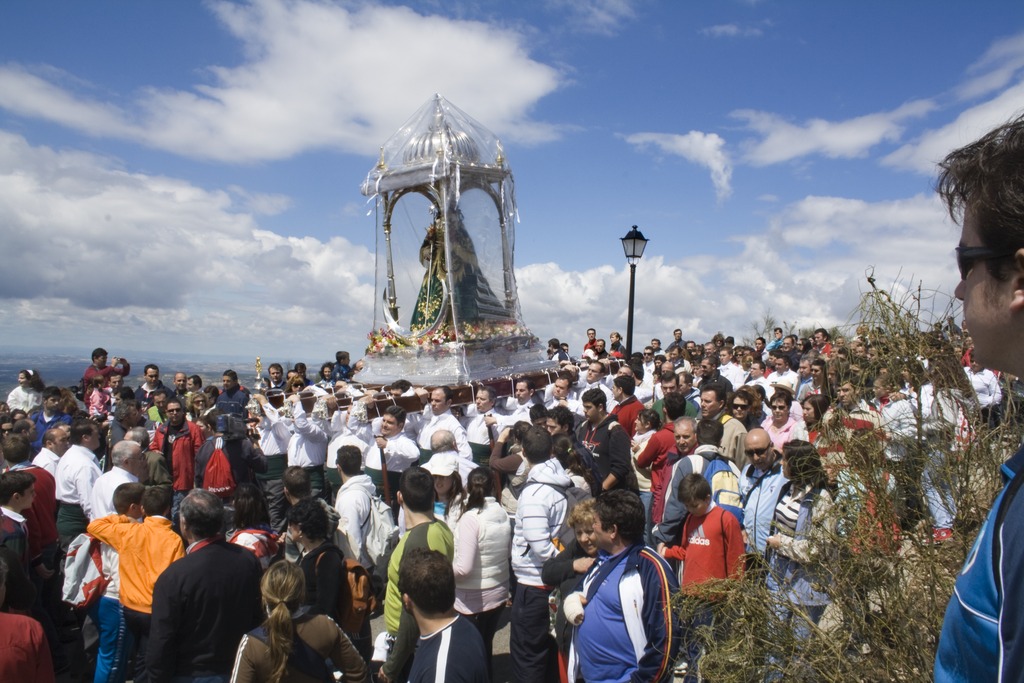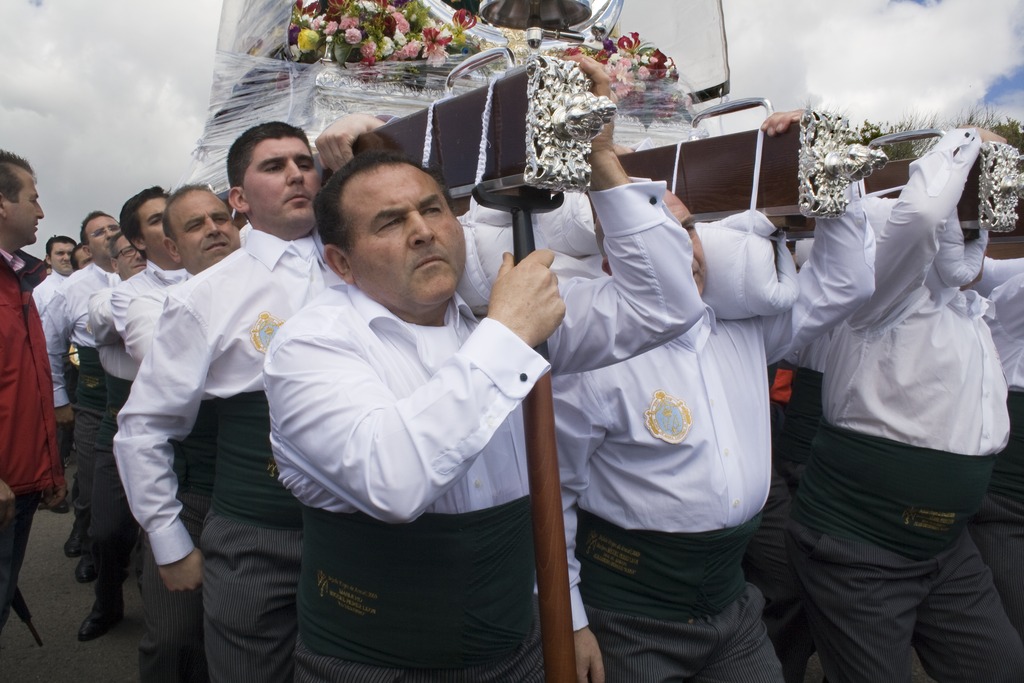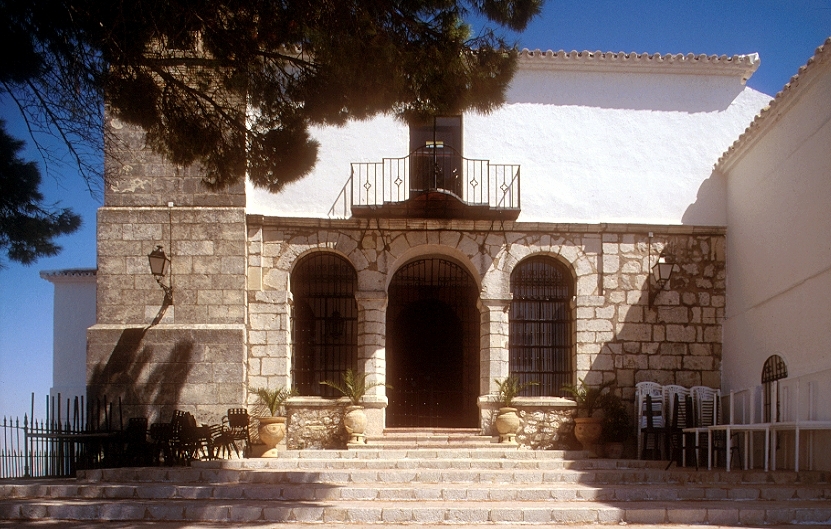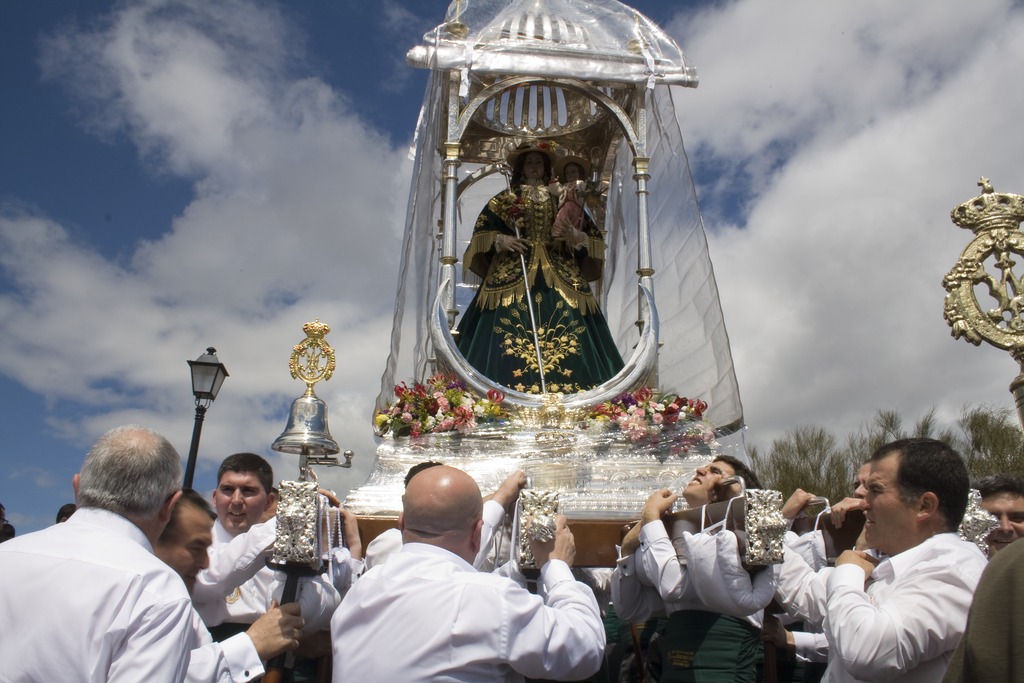Aracelitan Festivities. Lucena (Córdoba)
The Aracelitan Festivities, declared of National Tourist Interest, are, together with Holy Week, one of the most deeply-rooted and popular traditions in Lucena.
Origins:
The first document on the arrival of the image of the Virgin of Araceli in Lucena dates back to 1562 and is kept in the municipal historical archive. On 25 April of that year, Don Luis Fernández de Córdoba, Lord of Lucena, returned from Rome, bringing with him the image of a Madonna, inspired by the one venerated in the church of Araceli, on the Capitoline Hill. Once in the vicinity of Lucena, the horses were surprised by a great storm that caused the animals to scatter. The box carrying the image of the Virgin miraculously appeared on the summit of the Sierra de Aras and, since then, this circumstance has been attributed a divine dimension, a design of Providence to establish the cult of the Virgin on that height. In 1563 there is already evidence of the existence of a modest temple on the summit of Aras, as well as the celebration of her feast day on the first Sunday in May.
The first descent of the Virgin is recorded on 30 April 1588. In the midst of a severe drought, the first bringing down to Lucena took place, an event that was repeated the following year. In 1598 it was brought again to Lucena to implore rain. It was not until the 18th century that the image was brought down regularly. She has been the Patron Saint of Lucena since 1851, and in 1948 she was declared Patron Saint of the Andalusian countryside.
On the penultimate Sunday in April, the pilgrimage to bring down the image of Nuestra Señora de Araceli from her sanctuary to the town takes place.
The festive morning begins at dawn, when a huge multitude of devotees make their way to the summit of the Sierra de Aras in search of the Patron Saint.
At three o’clock in the afternoon, with the Virgin dressed as a Shepherdess on her silver platform on the shoulders of her santeros (devotees) and amidst the fervour of thousands of pilgrims, the journey begins, amidst a sea of olive groves, to take the venerated image to Lucena.
The official reception takes place at the place known as Puerta de la Mina, where the authorities, the clergy, the Aracelitana Mayor and her court of ladies are all present. There, the people gather to accompany the Virgin, amidst music and fireworks, through the streets of Lucena, until she is installed in the parish church of San Mateo while the Aracelitan hymns are sung.
On the Friday night before the first Sunday in May, the festivities begin with the proclamation of the aracelitana mayor and her court of ladies, and the literary act of the proclamation.
On the Saturday before the first Sunday in May, the Offering of Flowers takes place, one of the most beautiful events of the festivity. It is attended by representatives of all the institutions, associations, brotherhoods, the Aracelitana mayor and her court, dressed in their typical costume, the Archconfraternity and the municipal corporation, together with thousands of people who bring their flowers to the Patron Saint of Lucena.
On the first Sunday in May, the day of celebration of Virgen de Araceli, after a thunderous reveille, the solemn religious service in honour of the patron saint begins, with a Mass in which the Coral Lucentina (choir) performs the Misa del Campo Andaluz (Mass of the Andalusian countryside).
At six o’clock in the evening, once the image has been placed on its throne, the main parish church is opened to the people, awaiting the processional departure, which takes place at eight o’clock. On the shoulders of the santeros, the procession goes around the main streets and squares of the town.
After a devout procession, the parade enters Plaza Nueva at 11.30 p.m. and a fireworks display begins. The procession of the patron saint approaches the temple amidst the explosion of thousands of fireworks as an offering of fire to the Virgin.
On the first Sunday in June, the pilgrimage back to the sanctuary of Aras brings the festivities to a close.
On the Saturday night before the pilgrimage, a farewell Mass is held, and on Sunday morning the procession starts the return journey to the sanctuary in the mountains, followed by horsemen and beautifully decorated carriages. After the official farewell, the people take the float carrying the Virgin and set off on the return journey to the summit, which is reached at three o’clock midday.
Period / Occurrence:
The descent of the Virgin is aIways celebrated on the penultimate Sunday in April.
On the first Sunday in May is the day of celebration of Virgen de Araceli.
On the first Sunday in June, the Virgin is carried back in pilgrimage to the sanctuary of Aras.

Procesión de la Virgen de Araceli. Photo: Mª del Rosario Ortiz Amores. © Instituto Andaluz del Patrimonio Histórico
IAPH image under the conditions established under license cc-by 3.0 de Creative Common. https://creativecommons.org/licenses/by/3.0/es/

Cuadrilla de santeros llevando a la Virgen de Araceli. Photo: Mª del Rosario Ortiz Amores. © Instituto Andaluz del Patrimonio Histórico
IAPH image under the conditions established under license cc-by 3.0 de Creative Common. https://creativecommons.org/licenses/by/3.0/es/

Vista general de la fachada principal de la Ermita de Araceli. Photo: Javier Romero García. © Instituto Andaluz del Patrimonio Histórico
IAPH image under the conditions established under license cc-by 3.0 de Creative Common. https://creativecommons.org/licenses/by/3.0/es/

Procesión de la Virgen de Araceli. Photo: Mª del Rosario Ortiz Amores. © Instituto Andaluz del Patrimonio Histórico
IAPH image under the conditions established under license cc-by 3.0 de Creative Common. https://creativecommons.org/licenses/by/3.0/es/

